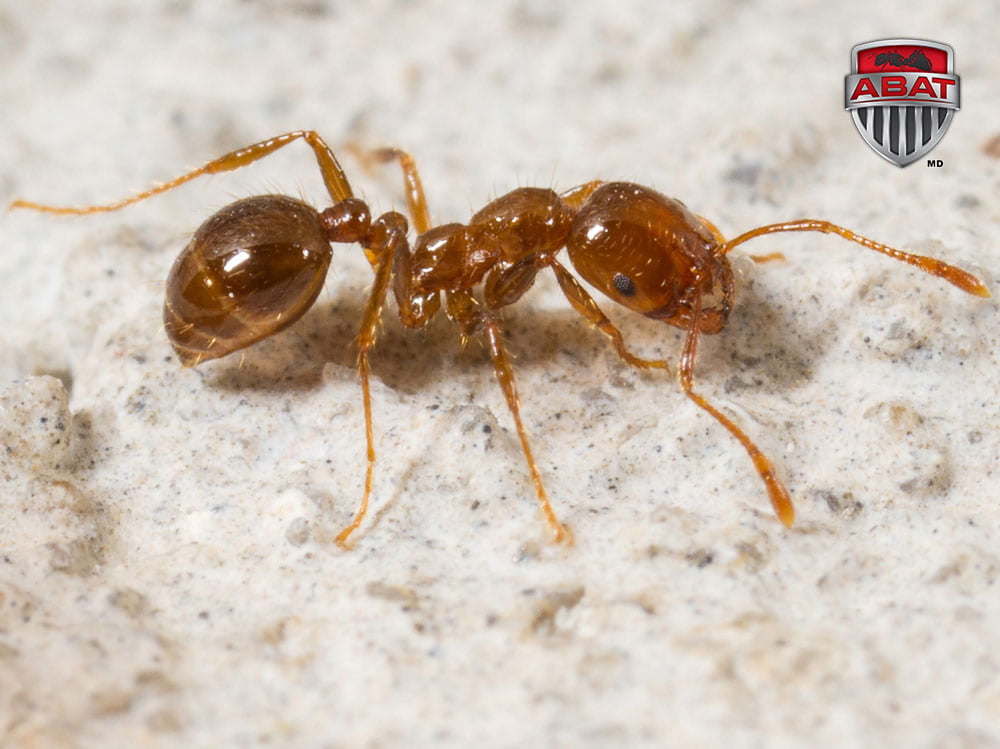| French name | Fourmi de feu |
| English name | Fire ants |
| Latin Name | Solenopsis invicta |
| Class | Insecta |
| Order | Hymenoptera |
| Family | Formicidae |

Part of the family Formicidae, the fire ant (Solenopsis invicta) – in Spanish, hormiga de fuego – is a social insect that lives in hierarchical colonies. Each caste has its function and a specific job within the colony.
As for all ants, the queen is the sole reproductive female, whereas the soldiers and workers are sterile. Their main role is to defend and feed the colony.
If you're not sure about the kind of ants that are invading your home, please check this articles
A very invasive ant in Honduras and on the Island of Útila
This species of ant was introduced to North America in the 1930’s. However, because of the development of many means of transportation (air planes, trains, ships, etc.), fire ants were able to colonize several other countries.
This same phenomenon occurs with other great travellers, bed bugs.
Fire ants have become very invasive in Honduras and especially on the Island of Útila. Anthills are found in local residences as well as in food shops, hotels and restaurants.
Vacation homes that are occupied only a few weeks per year are even more vulnerable because the insect is not immediately chased away upon its arrival in the premises.
The ants invade kitchens, bedrooms, utility rooms below the house, etc. They constitute a hygiene problem for food shops and in hotels, where they can sneak into tourists’ luggage.
The fire ant is a scourge when it builds its nest in a home
It devours everything in its path and feeds on sugar, leaves, fruit, grains, mushrooms. It is also capable of eating other insects or animals that are much larger than it, such as chicks or lizards.
Implementing a means to control them is difficult because they are aggressive and particularly resistant. Elevated temperatures and humid climates do not prevent them from developing. Exterminating them calls for specific competence and special expertise. Indeed, to efficiently eliminate these pests, accurate knowledge about their living habits is required in order to approach their nest without being stung.
An aggressive ant that has a stinger
The fire ant is aptly named. It is aggressive, has a stinger at the end of its abdomen, and it stings just like a bee or a wasp. Fire ants can sting several times in a row and attack humans while they’re asleep or even domestic animals.
A sharp, burning pain is felt when it injects its venom. Its sting is not fatal but will cause significant itching and redness on the skin as well as a secretion of pus. Only see a doctor if the swelling persists over time, as a course of antibiotics may be needed.
When the exterminator (an expert in pest control) begins a treatment, he must use efficient means to control these invasive ants over the long term.
Do you own a home in Honduras?
Beware – ants often take advantage of your absence to set up their abode in your home. To avoid any bad surprises during your vacation, a few precautions are necessary.
To keep your home healthy and pleasant to live in, simple steps can help you to avoid being infested by ants. Don’t keep any food or store it all in air tight containers; don’t leave garbage lying on the ground, apply insecticidal powder where the ants are accustomed to pass.
Your worst enemy, however, is humidity. To fight humidity:
- Install ventilation equipment to keep rooms well aired
- Install dehumidifiers to keep the environment clean
- Replace any leaky faucets
- Caulk the waste water system’s pipework
- Make sure your gutters are in good repair
- Have the premises and the basement inspected regularly
Pest control companies that specialize in integrated pest control management can offer to inspect your home in order to detect the presence of ants or other insects (cockroaches, bed bugs, etc.).
Diving or sightseeing in Honduras?
Honduras – especially the Island of Útila – is a haven of peace, with its beaches of white sand and the blue, warm Caribbean ocean. On the other hand, the ambient heat and humidity are two factors that contribute to the proliferation of insects.
Hotels, restaurants, businesses and means of transportation can carry insects, including ants. A few insects settled in your suitcase are enough to create a colony that will be returning home with you, without your knowledge.
There are solutions to avoid travelling with ants. You can ask an insect specialist to inspect your luggage. Only the eye of an expert can detect whether an insect has decided to make its home inside your suitcase.
How do you eliminate fire ants?
Insecticides are used to fight these invasive ants. Scientists are also trying to find other solutions of a biological nature to eliminate them, such as:
- The microspore protozoan Thelohania solenopsae
- The fungus Beauveria bassiana
- The fly Pseudacteon curvatus
- A parasite ant, Solenopsis daguerri (Santschi), that invades a colony and kills the queen
- The giant anteater
In order to completely eliminate ants, it is necessary to first identify the species. Indeed, some species of ants like the Argentine ant or the carpenter ant cannot be eliminated with the same methods used for fire ants.
Before any action is taken, the expert in pest control management must therefore identify the species, assess the number of ants present, find the anthill and use products that will work, all the while protecting himself from being stung.
A worthy mention can be given to an original idea tried by an artist, who poured liquid aluminum in an empty anthill to turn it into a work of art – worth a look!
Reproduction of Solenopsis invicta
The queen is the sole reproductive female, and it lays thousands of eggs. Workers and soldiers are sterile. Their role is to ensure the anthill’s protection and food supply. The males die immediately after mating with the queen. When the eggs hatch, the larvae are cared for diligently by the worker ants.
At maturity, the larva becomes a pupa and finally a worker, a soldier, or a male or female ant.
Their nest can reach up to 45 cm in length and can be located in gardens or inside homes.
While fire ants are very resistant to heat, they are sensitive to cold. If temperatures remain low for too long (from -5 to -10°C), the colony can experience a high mortality rate and even disappear.


